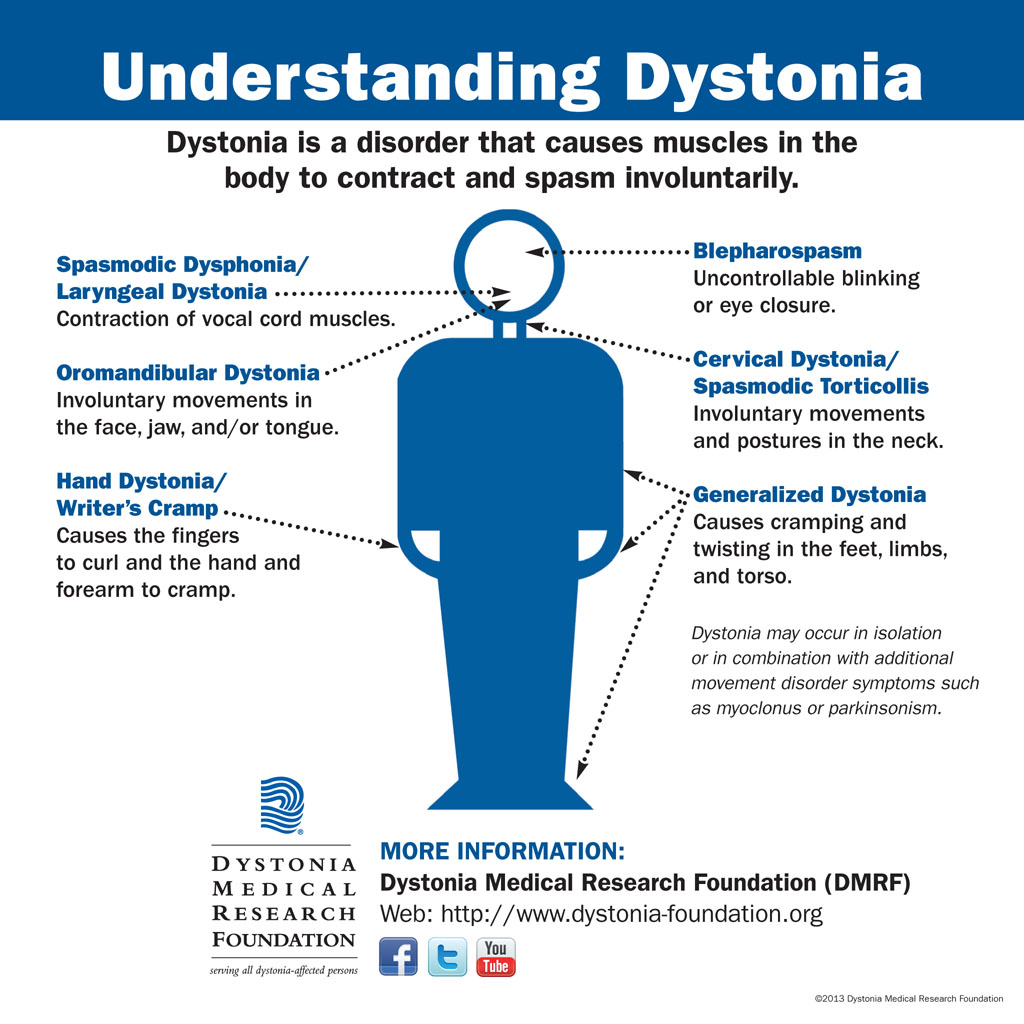The symptoms of dystonia can vary, depending on the type of dystonia and when it develops.
In early-onset dystonia, the symptoms begin during childhood or early adulthood. Symptoms usually start in the legs or arms, before spreading to other limbs and sometimes the upper part of the body.
Dystonia that starts as an adult (late-onset) usually begins in the head, neck or one of the arms, and doesn’t progress to affect other parts of the body.
Early-onset dystonia
Generalised dystonia
Generalised dystonia often begins around the time a child reaches puberty. The symptoms usually begin in one of the limbs, before spreading to other parts of the body.
Symptoms of generalised dystonia can include:
muscle spasms
having an abnormal, twisted posture
a foot, leg or arm turning inwards
body parts jerking rapidly
Dopa-responsive dystonia
Dopa-responsive dystonia is a type of generalised dystonia.
The symptoms of this type of dystonia usually begin during childhood, between the ages of 6 and 16 years. The most common symptom is an abnormal, stiff way of walking. The sole of the foot can bend upwards or the foot may turn outwards at the ankle.
Some people with dopa-responsive dystonia may also have muscle stiffness and spasms in their arms and torso.
Myoclonus dystonia
Myoclonus dystonia is a rare type of segmental dystonia that affects the muscles in the arms, neck and torso.
Segmental dystonia affects two or more connected parts of the body. It causes sudden “jerk-like” spasms (myoclonus) that are similar to the spasms someone has when they get an electric shock.
Paroxysmal dystonia
Paroxysmal dystonia is a rare type of dystonia, where muscle spasms and unusual body movements only occur at certain times. The sudden onset of symptoms is known as an attack.
The symptoms of paroxysmal dystonia can be similar to the symptoms of an epileptic fit. However, during an attack, only your muscles will be affected. Unlike epilepsy, you won’t lose consciousness and you’ll remain fully aware of your surroundings. Attacks can last from a few minutes to several hours.
Certain situations or substances can trigger an attack of paroxysmal dystonia, including:
alcohol
coffee
sudden movement
Late-onset dystonia
Cervical dystonia
Cervical dystonia, also known as torticollis, is the most common form of dystonia. It’s a type of focal dystonia (where only one body part is affected) that affects the neck muscles.
Involuntary contractions and spasms in the neck muscles can range from mild to severe and cause your head and neck to twist or be pulled forwards, backwards or from side to side.
Muscle spasms and contractions often cause neck pain and stiffness.
The symptoms of cervical dystonia can sometimes be relieved by touching your chin, neck or the back of your head. The reasons for this are unclear.
Blepharospasm
Blepharospasm is a type of focal dystonia that causes the muscles around your eyes to spasm involuntarily.
Uncontrollable eye closure is a common characteristic of blepharospasm. In the most severe cases, a person may be unable to open their eyes for several minutes, effectively making them blind for short periods of time.
Frequent blinking, eye irritation and sensitivity to light (photophobia) are also possible characteristics of blepharospasm.
If you have blepharospasm, the pattern of your symptoms can change throughout the day. For example, you may have few or no symptoms when you wake up in the morning, but they may start to appear or get worse when you’re tired or stressed.
Hemifacial spasm
Although it isn’t considered to be a dystonia, hemifacial spasm can cause similar symptoms, with repetitive twitching of the muscles on one side of the face, usually around the eyes and mouth. It can respond well to botulinum toxin injections.
Laryngeal dystonia
Laryngeal dystonia is a type of focal dystonia that causes the muscles of the voice box (larynx) to spasm. Your voice can either sound “strangled” or very quiet and “breathy”, depending on whether the muscles of your larynx spasm outwards or inwards.
Writer’s cramp
Writer’s cramp, also known as task-specific dystonia, is a type of focal dystonia that causes cramps and involuntary movements in the muscles of the arm and wrist. This makes handwriting difficult and uncomfortable.
As the name suggests, writer’s cramp usually affects people who do a lot of writing. Other less well-known types of task-specific dystonia include:
musician’s cramp
golfer’s cramp
typist’s cramp
As in other types of late-onset dystonias, tremor (shaking) may also be a prominent feature.
Oromandibular dystonia
Oromandibular dystonia is a type of segmental dystonia that affects the lower facial muscles, tongue or jaw.
It can cause a number of different facial distortions, including grimacing and lip pursing. The jaw can repeatedly open and close or pull outwards and upwards. Tongue movements can be continuous or occur intermittently.
In some cases, the symptoms of oromandibular dystonia only occur when your mouth is being used, such as while eating or talking. In other cases, the symptoms may be improved by talking or chewing.
If you have oromandibular dystonia, you may also have difficulty swallowing (dysphagia).
